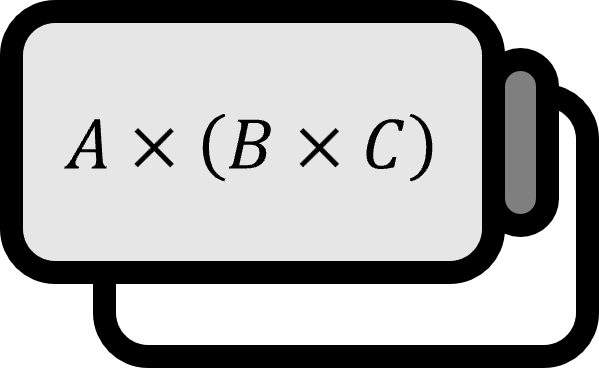레비-치비타 심볼
정의
다음과 같이 정의되는 $\epsilon_{ijk}$를 레비-치비타 심볼Levi-Civita-symbol 이라고 한다.
$$ \epsilon_{ijk} = \begin{cases} +1 & \text{if} \ \epsilon_{123}, \epsilon_{231}, \epsilon_{312} \\ -1 & \text{if} \ \epsilon_{132}, \epsilon_{213}, \epsilon_{321} \\ 0 & \text{if} \ i=j \ \text{or} \ j=k \ \text{or} \ k=i \end{cases} $$
설명
크로네커 델타가 인덱스끼리 값이 같은지만 따졌다고 한다면 레비-치비타 심볼은 정의에서 나타나듯이 인덱스의 순서도 값에 영향을 미친다. $\epsilon_{ijk}$는 $i$, $j$, $k$가 중복없이 오름차순$(1\to 2\to 3\to 1)$으로 있으면 $+1$, 중복없이 내림차순$(3\to 2\to 1\to 3)$이면 $-1$, 하나라도 중복되면 $0$을 값으로 가진다. 간단하게 적으면 위와 같고 모든 값을 나열하면 총 $3\times 3\times 3=27$개이며 그 중 $0$이 아닌 값은 $6$개이다.
$$ \begin{array}{|c|c|c|c|}\hline i=1 & k=1 & k=2 & k=3 \\ \hline j=1 & \epsilon_{111}=0 & \epsilon_{112}=0 & \epsilon_{113}=0 \\ j=2 & \epsilon_{121}=0 & \epsilon_{122}=0 & \epsilon_{123}=1 \\ j=3 & \epsilon_{131}=0 & \epsilon_{132}=-1 & \epsilon_{133}=0 \\ \hline \end{array}\quad \begin{array}{|c|c|c|c|}\hline i=2 & k=1 & k=2 & k=3 \\ \hline j=1 & \epsilon_{211}=0 & \epsilon_{212}=0 & \epsilon_{213}=-1 \\ j=2 & \epsilon_{221}=0 & \epsilon_{222}=0 & \epsilon_{223}=0 \\ j=3 & \epsilon_{231}=1 & \epsilon_{232}=0 & \epsilon_{233}=0 \\ \hline \end{array} \\ {} \\ \begin{array}{|c|c|c|c|}\hline i=3 & k=1 & k=2 & k=3 \\ \hline j=1 & \epsilon_{311}=0 & \epsilon_{312}=1 & \epsilon_{313}=0 \\ j=2 & \epsilon_{321}=-1 & \epsilon_{322}=0 & \epsilon_{323}=0 \\ j=3 & \epsilon_{331}=0 & \epsilon_{332}=0 & \epsilon_{333}=0 \\ \hline \end{array} $$
$3$차 텐서의 한 예이다.
예시
외적
레비-치비타 심볼을 사용하면 두 벡터의 외적을 굉장히 간단하게 표현할 수 있다. 3차원 직교좌표계에서 두 벡터의 외적은 아래와 같다.
$$ \begin{align*} \mathbf{A} \times \mathbf{B} =&\ \hat{\mathbf{e}}_{x} (A_{y}B_{z}-A_{z}B_{y}) + \hat{\mathbf{e}}_{y} (A_{z}B_{x}-A_{x}B_{z}) + \hat{\mathbf{e}}_{z} (A_{x}B_{y}-A_{y}B_{x}) \\ =&\ \begin{vmatrix} \hat{\mathbf{e}}_{x} \quad \hat{\mathbf{e}}_{y} \quad \hat{\mathbf{e}}_{z} \\ A_{x} \quad A_{y} \quad A_{z} \\ B_{x} \quad B_{y} \quad B_{z} \end{vmatrix} \end{align*} $$
여기서 $x=1$, $y=2$, $z=3$이라고 두면 두 벡터의 외적은 레비-치비타 심볼을 사용해서 아래와 같이 표현할 수 있다.
$$ \sum\limits_{i=1}^{3} \sum\limits_{j=1}^{3} \sum\limits_{k=1}^{3} {\epsilon_{ijk} \hat{\mathbf{e}}_{i} A_{j}B_{k}} $$
$0$이 아닌 항만 풀어서 적어보면 다음과 같다.
$$ \begin{align*} & \sum\limits_{i=1}^{3} \sum\limits_{j=1}^{3} \sum\limits_{k=1}^{3} {\epsilon_{ijk} \hat{\mathbf{e}}_{i} A_{j}B_{k}} \\ =&\ \epsilon_{123} \hat{\mathbf{e}}_{1}A_{2}B_{3} + \epsilon_{132} \hat{\mathbf{e}}_{1}A_{3}B_{2} + \epsilon_{ 231 }\hat{\mathbf{e}}_{2}A_{3}B_{1} + \epsilon_{213}\hat{\mathbf{e}}_{2}A_{1}B_{3} + \epsilon_{312}\hat{\mathbf{e}}_{3}A_{1}B_{2} + \epsilon_{321}\hat{\mathbf{e}}_{3}A_{2}B_{1} \end{align*} $$
여기서 $\epsilon_{123}=\epsilon_{231}=\epsilon_{312}=1$, $\epsilon_{132}=\epsilon_{213}=\epsilon_{321}=-1$을 대입하고 정리하면 다음과 같다.
$$ \begin{align*} & \sum\limits_{i=1}^{3} \sum\limits_{j=1}^{3} \sum\limits_{k=1}^{3} {\epsilon_{ijk} A_{i}B_{j}}\hat{\mathbf{e}}_{k} \\ =&\ \hat{\mathbf{e}}_{1}\left( A_{2}B_{3} - A_{3}B_{2} \right) + \hat{\mathbf{e}}_{2}\left( A_{3}B_{1} - A_{1}B_{3} \right) + \hat{\mathbf{e}}_{3}\left( A_{1}B_{2} - A_{2}B_{1} \right) \end{align*} $$
마지막으로 $1$, $2$, $3$에 각각 $x$, $y$, $z$를 대입하면 다음을 얻는다.
$$ \hat{\mathbf{e}}_{x}\left( A_{y}B_{z} - A_{z}B_{y} \right) + \hat{\mathbf{e}}_{y}\left( A_{z}B_{x} - A_{x}B_{z} \right) + \hat{\mathbf{e}}_{z}\left( A_{x}B_{y} - A_{y}B_{x} \right) $$
따라서 아래의 결과를 얻는다.
$$ \mathbf{A} \times \mathbf{ B } = \sum \limits_{i=1}^{3} \sum \limits_{j=1}^{3} \sum \limits_{k=1}^{3} \epsilon_{ijk}\hat{\mathbf{e}}_{i}A_{j}B_{k} $$
아인슈타인 노테이션을 쓰면 다음과 같다.
$$ \mathbf{A} \times \mathbf{ B } = \epsilon_{ijk}\hat{\mathbf{e}}_{i}A_{j}B_{k} $$
외적의 각 성분도 쉽게 표현할 수가 있는데 위 식에서 알 수 있듯이 $(\mathbf{A} \times \mathbf{B})$의 $i$ 성분은 다음과 같다.
$$ (\mathbf{A} \times \mathbf {B})_{i}=\epsilon_{ijk}A_{j}B_{k} $$
행렬식
$3 \times 3$ 행렬 $A = [a_{ij}]$의 행렬식은 다음과 같이 나타난다.
$$ \begin{vmatrix} a_{11} & a_{12} & a_{13} \\ a_{21} & a_{22} & a_{23} \\ a_{31} & a_{32} & a_{33} \\ \end{vmatrix} = \sum\limits_{i,j,k=1}^{3} \epsilon_{ijk}a_{1i}a_{2j}a_{3k} $$
보이는 법은 간단하다. 행렬식을 전개하고 행렬의 각 성분의 두번째 인덱스를 잘 보면, 인덱스의 레비-치비타 심볼이 각 항의 부호와 같다는 것을 알 수 있다.
$$ \begin{align*} & \det A \\ &= a_{11}(a_{22}a_{33} - a_{23}a_{32}) + a_{12}(a_{23}a_{31} - a_{21}a_{33}) + a_{13}(a_{21}a_{32} - a_{22}a_{31}) \\ &= a_{11}a_{22}a_{33} - a_{11}a_{23}a_{32} + a_{12}a_{23}a_{31} - a_{12}a_{21}a_{33} + a_{13}a_{21}a_{32} - a_{13}a_{22}a_{31} \\ &= a_{1\textcolor{red}{1}}a_{2\textcolor{red}{2}}a_{3\textcolor{red}{3}} - a_{1\textcolor{red}{1}}a_{2\textcolor{red}{3}}a_{3\textcolor{red}{2}} + a_{1\textcolor{red}{2}}a_{2\textcolor{red}{3}}a_{3\textcolor{red}{1}} - a_{1\textcolor{red}{2}}a_{2\textcolor{red}{1}}a_{3\textcolor{red}{3}} + a_{1\textcolor{red}{3}}a_{2\textcolor{red}{1}}a_{3\textcolor{red}{2}} - a_{1\textcolor{red}{3}}a_{2\textcolor{red}{2}}a_{3\textcolor{red}{1}} \\ &= \epsilon_{\textcolor{red}{123}}a_{1\textcolor{red}{1}}a_{2\textcolor{red}{2}}a_{3\textcolor{red}{3}} + \epsilon_{\textcolor{red}{132}}a_{1\textcolor{red}{1}}a_{2\textcolor{red}{3}}a_{3\textcolor{red}{2}} + \epsilon_{\textcolor{red}{231}}a_{1\textcolor{red}{2}}a_{2\textcolor{red}{3}}a_{3\textcolor{red}{1}} + \epsilon_{\textcolor{red}{213}}a_{1\textcolor{red}{2}}a_{2\textcolor{red}{1}}a_{3\textcolor{red}{3}} + \epsilon_{\textcolor{red}{312}}a_{1\textcolor{red}{3}}a_{2\textcolor{red}{1}}a_{3\textcolor{red}{2}} + \epsilon_{\textcolor{red}{321}}a_{1\textcolor{red}{3}}a_{2\textcolor{red}{2}}a_{3\textcolor{red}{1}} \\ &= \sum\limits_{i,j,k=1}^{3} \epsilon_{ijk}a_{1i}a_{2j}a_{3k} \end{align*} $$
공식
(a) 한 개의 인덱스가 같은 경우: $\epsilon_{ijk}\epsilon_{lmk}=\delta_{il}\delta_{jm}-\delta_{im}\delta_{jl}$
(b) 두 개의 인덱스가 같은 경우: $\epsilon_{ijk}\epsilon_{ljk}=2\delta_{il}$
(c) 세 개의 인덱스가 같은 경우: $\epsilon_{ijk}\epsilon_{ijk}=6$

 저희들의 저서 「줄리아 프로그래밍」이 2024 세종도서 학술부문에 선정되었습니다!
저희들의 저서 「줄리아 프로그래밍」이 2024 세종도서 학술부문에 선정되었습니다!

